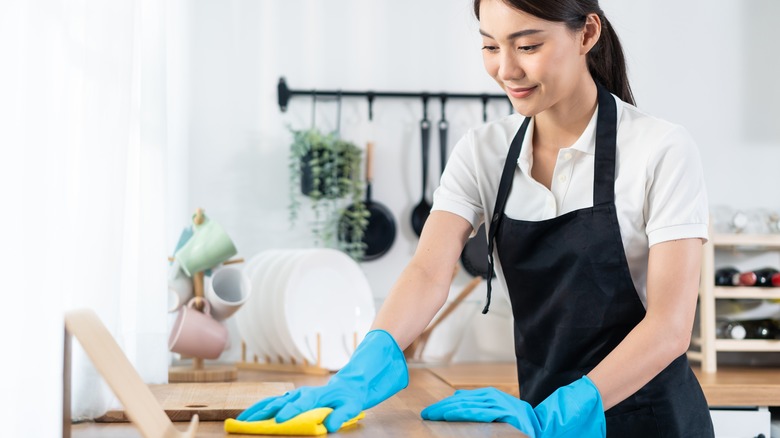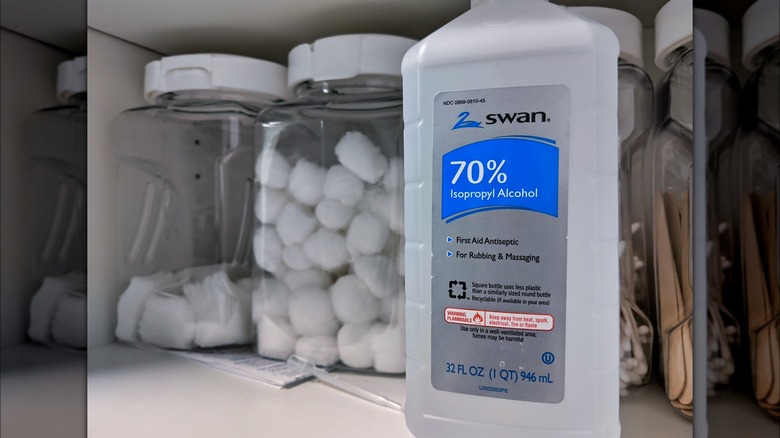This Homemade Scrub Can Tackle Stubborn Grime & You Only Need Two Household Ingredients
Whether it's stains or a build-up of debris and dirt, if your kitchen countertops, floor, or other hard surfaces just don't look new any longer, a simple homemade scrub could give you the ability to revive surfaces with ease. A simple scrub made with isopropyl alcohol (usually found in the medicine cabinet) and salt is all it takes to create a powerful, dirt-busting cleaning agent that costs very little and works very well, and you likely have what you need right now.
This scrub's ingredients combine to create a solution that grinds into the surface where microscopic fissures and cracks trap and hold onto dirt and debris. That's where stains hide, too. By working to break up that link, it becomes possible for you to simply wipe away the caked-on mess to reveal a clean, sometimes like-new, surface in a matter of minutes. This helpful cleaning agent may work on surfaces other solvents haven't been able to break through as well.
There are limitations to this process, and some materials could suffer damage from the rubbing alcohol, especially with damage to the color. However, for many nonporous surfaces, this simple-to-use combination will give you a bit more fighting power against the stain. The rubbing alcohol may even help to disinfect the surface a bit, helping you with tough, caked-on kitchen stains and removing the bacteria, mold, mildew, and other germs that could be present on those surfaces.
Why isopropyl alcohol and salt works as a cleaning agent
This homemade scrub's base is isopropyl alcohol — a type of organic compound easily recognized by its strong scent. It's found in various cleaning products, including some disinfectant sprays, cleaning detergents, and some medications. It's made by combining water with propene, a compound derived from natural gas, petroleum, or other types of fossil fuels. Isopropyl alcohol kills organisms through denaturation, a process in which the proteins are broken down and, ultimately the cell's structure fails, making it impossible for the cells to work as they should. It also dissolves the lipids within these organisms, working as a type of degreasing agent to lift off unwanted material.
By adding salt to rubbing alcohol, you add some grit, a bit of abrasive texture that, when some pressure is applied, can grind into the surface of the material and break it down. The salt isn't likely to cause any damage to the surface as a food-grade product without any chemical additives. Salt is abrasive due to the very tiny, even microscopic crystals that help it form. These crystals create small, sharp edges that aren't likely to damage your skin but can damage the fine surface of various materials, breaking down the cell walls there. You could see how this might work by looking at salt under a microscope, but even just rubbing it between two fingers, you can feel the abrasive texture that's going to work to break down debris.
How to make a homemade cleaning scrub
Once you've wiped down a surface and found a stain or material that's ground into it, head to your kitchen. You can use these ingredients in several ways to yield a powerful cleaning solvent. The simplest of options to clean a kitchen countertop, for example, is to sprinkle a small amount of salt onto the surface directly and then use a clean towel with rubbing alcohol to rub into the troublesome area. For a small spot, that's all it may take (with a bit of muscle to handle the rubbing!)
Another option is to make an actual scrub. Choose a product with a concentration level of 60% to 90% alcohol (diluted rubbing alcohol could be less effective). Pour simple table salt into a bowl (avoid any colored or fragrant varieties here). Then, add enough alcohol to make a paste. Apply the paste directly to the surface or onto a sponge and rub it into the discoloration in a circular motion. That's going to help loosen the bond holding it in place, allowing you to simply wipe it off. You can use this method to clean quartz countertops and other natural stones, tile, and other hard surfaces. If you have a material that could bleed color, test a small area before using it. Avoid using this scrub on vinyl, rubber, and some plastics with a softer exterior. Also, avoid using it on surfaces with a painted or lacquered exterior.


